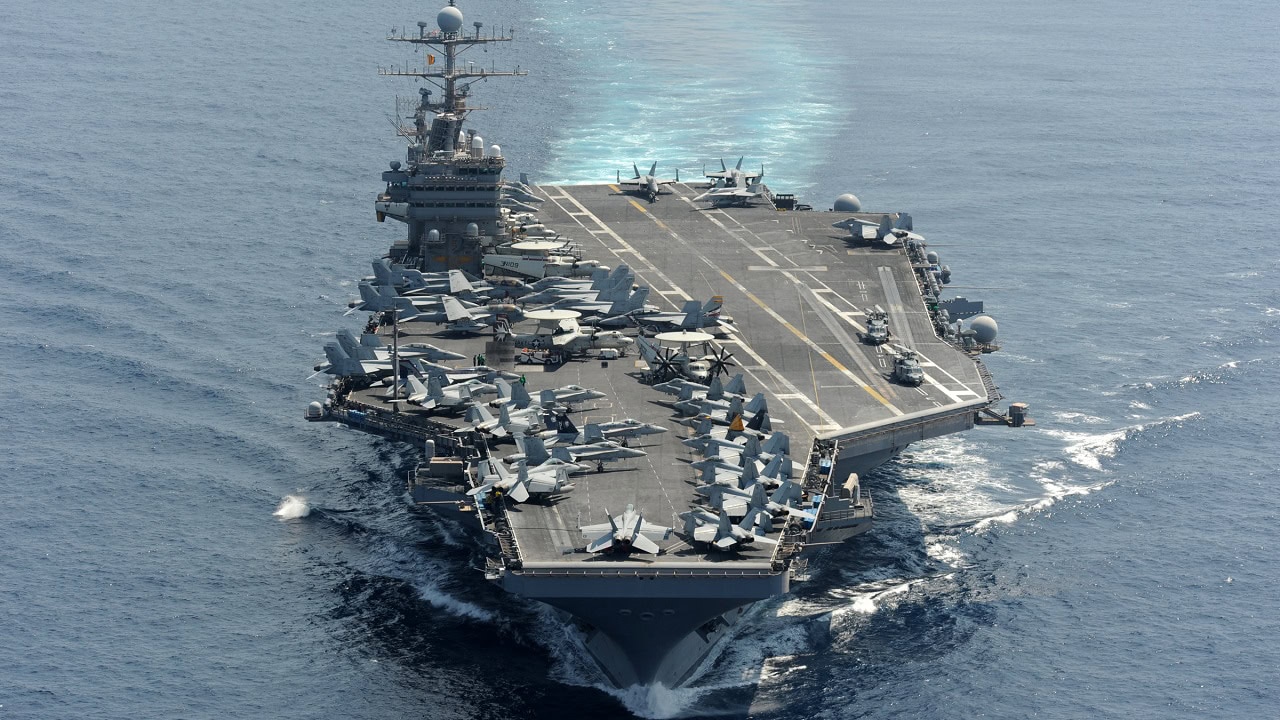“All good things must come to an end,” the saying goes. This is true even of a battle-honored aircraft carrier that served honorably for 50-plus years and was named for one of the heroes of the epic Battle of Midway. The carrier in question is the USS Nimitz, whose name honors one of the Navy’s greatest leaders, Fleet Admiral Chester W. Nimitz (1885-1966).
USS Nimitz Early History & Specifications
The USS Nimitz was laid down on June 22, 1968, by Newport News Shipbuilding. The vessel launched on May 13, 1972, and was commissioned on May 3, 1975, as CVAN 68. On June 30, 1975, she was re-designated CVN 68 (nuclear-powered multi-mission aircraft carrier) as part of a fleet realignment. The Nimitz was the lead ship of her class and one of the largest warships in the world, and is currently the oldest American carrier in active service. Appropriately, her nicknames are “Old Salt” and “Uncle Chester.”
The Nimitz has a displacement of 112,020 short tons, an overall hull length of 1,092 feet (1,040 feet at the waterline), a beam width of 252 feet, and a draft of 37 feet. Maximum speed is 31.5 knots (36.2 miles per hour). Crew complement is 3,532 commissioned officers and enlisted sailors in the ship’s company, along with an air wing of 2,480. Aircraft carrying capacity is 90 fixed-wing aircraft and helicopters. Defensive armament consists of two RIM-7 Seasparrow surface-to-air missile launchers, two RIM-116 Rolling Airframe Missile SAM launchers, two Phalanx Close-In Weapon System Gatling guns, four MK 38 25mm autocannon turrets, and ten .50 caliber turret emplacements.
The ship’s first taste of combat was during the Gulf of Sidra incident of August 1981, in which two of the ship’s F-14 Tomcats shot down two Libyan Sukhoi Su-22 “Fitters.” The Nimitz saw more extended combat against Ayatollah Khomeini’s naval cronies during Operation Earnest Will in 1987-1988. She relieved USS Ranger (CV-61) at the tail end of Operation Desert Storm in February 1991, and then contributed heavily to Operation Iraqi Freedom and Operation Enduring Freedom between 2003 and 2009.
On Nov. 3, 2014, the Nimitz notched another naval aviation historical milestone when the fifth-generation F-35 Lightning II touched down on a carrier at sea for the first time.
A Rather Daunting Task at Hand
The Nimitz is only the second nuclear-powered American carrier scheduled to be scrapped, the first one being the USS Enterprise (CVN-65), which was commissioned in 1961 and was also the world’s first nuclear-powered carrier in addition to being the longest naval vessel ever built.
There’s a problem, however, as Business Insider’s Michael Peck explains:
“The problem isn’t that the Navy doesn’t have experience dismantling nuclear-powered ships. The US Navy launched the first atomic submarine — the USS Nautilus — in 1954. (The first nuclear-powered surface ship was the Soviet icebreaker Lenin, launched in 1957.)… Since 1990, the Navy has inactivated — which entails removing the nuclear fuel and reactor compartment — more than 130 nuclear-powered ships, according to the GAO. In addition to carriers and subs, the Navy also built nine nuclear-powered cruisers in the 1960s and 1970s. The last of them, USS Arkansas, left service in 1998.
“But scrapping a 100,000-ton aircraft carrier is a much more ambitious project. To say the process is complicated — both technically and bureaucratically — would be an understatement…Navy shipyards are so overworked that they can’t provide required maintenance for active warships, let alone take apart obsolete ones.”
Moving Forward
Regardless of how the process unfolds, the scrapping of Nimitz and Enterprise brings about the end of an era. The vessels are tangible symbols of America’s Cold War power projection. Presumably this will leave more room in the Navy’s budget for the new generation Gerald R. Ford-class carriers, which carry a $37.3 billion program cost and a $12.998 billion unit cost. The Fords are being built with a larger deck space able to support a 33 percent increase in sortie rate over the Nimitz-class. The lead ship of the Ford-class finally made her maiden deployment in October 2022.
MORE: Why Putin Fears the M1 Abrams Tank
MORE: I Went to War in the Leopard 2 Tank Ukraine Wants
Christian D. Orr is a former Air Force Security Forces officer, Federal law enforcement officer, and private military contractor (with assignments worked in Iraq, the United Arab Emirates, Kosovo, Japan, Germany, and the Pentagon). Chris holds a B.A. in International Relations from the University of Southern California (USC) and an M.A. in Intelligence Studies (concentration in Terrorism Studies) from American Military University (AMU). He has also been published in The Daily Torch and The Journal of Intelligence and Cyber Security. Last but not least, he is a Companion of the Order of the Naval Order of the United States (NOUS).

